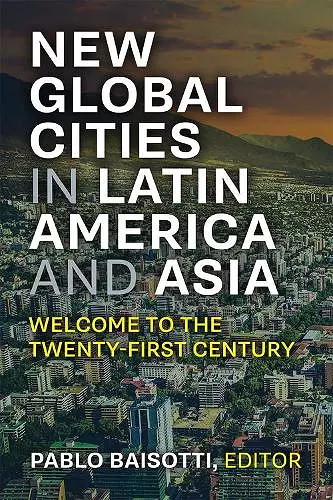New Global Cities in Latin America and Asia
Welcome to the Twenty-First Century
Format:Paperback
Publisher:The University of Michigan Press
Published:19th Apr '22
Should be back in stock very soon

New Global Cities in Latin America and Asia: Welcome to the Twenty-First Century proposes new visions of global cities and regions historically considered “secondary” in the international context. The arguments are not only based on material progress made by these metropolises, but also on the growing social difficulties experienced (e.g., organized crime, drug trafficking, slums, economic inequalities). The book illustrates the growth of cities according to these problems arising from the modernity of the new century, comparing Latin American and Asian cities.
This book analyzes the complex relationships within cities through an interdisciplinary approach, complementing other research and challenging orthodox views on global cities. At the same time, the book provides new theoretical and methodological tools to understand the progress of “Third World” cities and the way of understanding “globality” in the 21st century by confronting the traditional views with which global cities were appreciated since the 1980s. Pablo Baisotti brings together researchers from various fields who provide new interpretative keys to certain cities in Latin America and Asia.
“By the end of 2022, the world’s population numbered just over 7.8 billion. 56.4 percent of these live in large urban concentrations and almost two-thirds of that agglomeration is located in Asian and Latin American cities. That is the quantitative context of the book edited by Professor Pablo Baisotti. It is clear that the most fundamental political and social challenges of the Asian continent and the Latin American region in the very coming decades will revolve around the structure and institutional functioning of urban concentration.
In the Latin American region, meanwhile, other aspects of urban culture are observable, as listed in this book. It highlights, for instance, a great mobility of diverse groups and social strata among large cities. In more than one case, the population growth of some urban concentrations in the region is due to a growing interurban mobility, which has increased the number of inhabitants of some cities with immigrants from others, without noticeable altering the vegetative growth of large cities. The political effects have been obvious, though, since this mobility has gravitated to the presence of new ideological and institutional references.
This is a book that comprehensively covers the vicissitudes of urban agglomerations during the last twenty years. From their respective points of view, the authors converge in acknowledging the relevance of this issue from their respective realities. In short, it is an indispensable work in these matters and therefore it is convenient to have it at hand.”
—Roberto Durán, Professor, Institute of Political Science, Catholic University of Chile
* Roberto Durán *“This book constitutes a remarkable advance in the research on the rise and consolidation of global cities in Latin America and Asia. The contribution of various academics around the world makes it an avant-garde work in the study of Globalization and International Relations.”
—Fabio Sánchez, Sergio Arboleda University, Bogotá
* Fabio SánchISBN: 9780472055234
Dimensions: unknown
Weight: unknown
364 pages